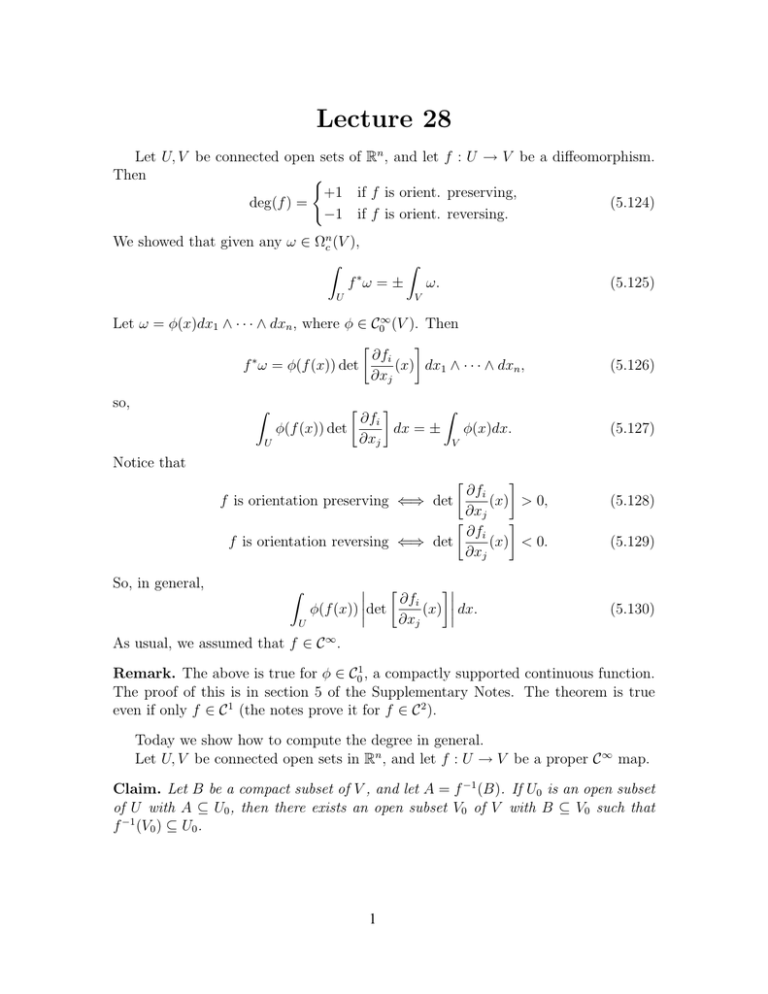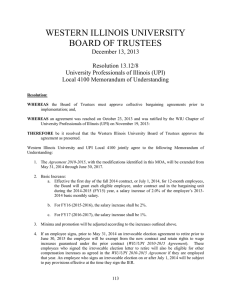Document 13570061
advertisement

Lecture 28
Let U, V be connected open sets of Rn , and let f : U → V be a diffeomorphism.
Then
�
+1 if f is orient. preserving,
deg(f ) =
(5.124)
−1 if f is orient. reversing.
We showed that given any ω ∈ Ωnc (V ),
�
�
∗
f ω=±
ω.
U
(5.125)
V
Let ω = φ(x)dx1 ∧ · · · ∧ dxn , where φ ∈ C0∞ (V ). Then
�
�
∂fi
∗
(x) dx1 ∧ · · · ∧ dxn ,
f ω = φ(f (x)) det
∂xj
(5.126)
so,
�
�
�
∂fi
φ(f (x)) det
dx = ±
φ(x)dx.
∂xj
U
V
�
(5.127)
Notice that
�
�
∂fi
f is orientation preserving ⇐⇒ det
(x) > 0,
∂xj
�
�
∂fi
f is orientation reversing ⇐⇒ det
(x) < 0.
∂xj
(5.128)
(5.129)
So, in general,
�
U
�
�
��
�
�
∂fi
�
(x) ��
dx.
φ(f (x)) �det
∂xj
(5.130)
As usual, we assumed that f ∈ C ∞ .
Remark. The above is true for φ ∈ C01 , a compactly supported continuous function.
The proof of this is in section 5 of the Supplementary Notes. The theorem is true
even if only f ∈ C 1 (the notes prove it for f ∈ C 2 ).
Today we show how to compute the degree in general.
Let U, V be connected open sets in Rn , and let f : U → V be a proper C ∞ map.
Claim. Let B be a compact subset of V , and let A = f −1 (B). If U0 is an open subset
of U with A ⊆ U0 , then there exists an open subset V0 of V with B ⊆ V0 such that
f −1 (V0 ) ⊆ U0 .
1
Proof. Let C ⊆ V be a compact set with B ⊆ Int C, and let W = f −1 (C) − U0 . The
set W is compact, so the set f (W ) is also compact. Moreover, f (W ) ∩ B = φ since
f −1 (B) ⊆ U0 .
Now, let V0 = Int C − f (W ). This set is open, and
f −1 (V0 ) ⊆ f −1 (Int C) − W
⊆ U0 .
(5.131)
Claim. If X ⊆ U is closed, then f (X) is closed in V .
Proof. Take any point p ∈ V − f (x). Then f −1 (p) ∈ U − X. Apply the previous
result with B = {p}, A = f −1 (p), and U0 = U − X. There exists an open set V0 � p
such that f −1 ⊆ U − X. The set V0 ∩ f (X) = φ, so V − f (X) is open in V .
We now remind you of Sard’s Theorem. Let f : U → V be a proper C ∞ map. We
define the critical set
Cf = {p ∈ U : Df (p) is not bijective}.
(5.132)
The set Cf is closed. The set f (Cf ) in V is a set of measure zero. The set f (Cf ) is
closed as well, since f is proper.
Definition 5.18. A point q ∈ V is a regular value of f if q ∈ V − f (Cf ).
Sard’s Theorem basically says that there are “lots” of regular values.
Lemma 5.19. If q is a regular value, then f −1 (q) is a finite set.
Proof. First, p ∈ f −1 (q) =⇒ p ∈
/ Cf . So, Df (p) : Rn → Rn is bijective. By the IFT,
the map f is a diffeomorphism of a neighborhood Up of p ∈ U onto a neighborhood
of q. In particular, since f is one­to­one and onto,
Up ∩ f −1 (q) = {p}.
(5.133)
Consider the collection {Up : p ∈ f −1 (q)}, which is an open cover of f −1 (q). The H­B
Theorem tells us that there exists a finite subcover {Upi , i = 1, . . . , N }. Hence,
f −1 (q) = {p1 , . . . , pN }.
(5.134)
Theorem 5.20. The degree of f is
deg(f ) =
N
�
i=1
2
σpi ,
(5.135)
where
�
+1 if Df (pi ) is orient. preserving,
σpi =
−1 if Df (pi ) is orient. reversing.
(5.136)
So, to calculate the degree, you just pick any regular value q and “count” the number
of points in the pre­image of q, keeping track of the value of σpi .
Proof. For each pi ∈ f −1 (q), let Upi be an open neighborhood of pi such that f maps
Upi diffeomorphically onto a neighborhood of q. We can assume that the Upi ’s do not
intersect.
Now, choose a neighborhood V0 of q such that
f −1 (V0 ) ⊆
Upi .
(5.137)
Next, replace each Upi by Upi ∩ f −1 (V0 ). So, we can assume the following:
1. f is a diffeomorphism of Upi onto V0 ,
2. f −1 (V0 ) = Upi ,
3. The Upi ’s don’t intersect.
Choose ω ∈ Ωnc (V0 ) such that
�
ω = 1.
(5.138)
V
Then,
�
∗
f ω=
��
U
Upi
i
=
f ∗ω
�
�
σpi
ω
(5.139)
ω = deg f,
(5.140)
V0
i
=
�
σpi .
i
But,
�
�
∗
f ω = (deg f )
U
U
so
�
σpi = deg f.
(5.141)
This is a very nice theorem that is not often discussed in textbooks.
The following is a useful application of this theorem. Suppose f −1 (q) is empty, so
q∈
/ f (U ). Then q ∈
/ f (Cf ), so q is a regular value. Therefore,
deg(f ) = 0.
This implies the following useful theorem.
3
(5.142)
Theorem 5.21. If deg(f ) =
� 0, then f : U → V is onto.
This theorem can let us know if a system of non­linear equations has a solution,
simply by calculating the degree. The way to think about this is as follows. Let
f = (f1 , . . . , fn ) and let q = (c1 , . . . , cn ) ∈ V . If q ∈ f (U ) then there exists a solution
x ∈ U to the system of non­linear equations
fi (x) = ci , i = 1, . . . , n.
4
(5.143)


